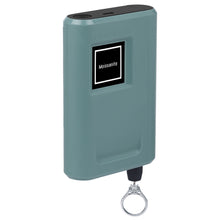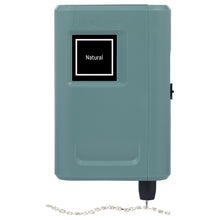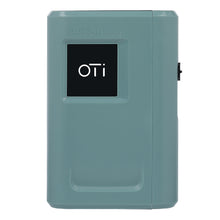Pickup available from Quicktest (WD18 8JA)
Email us
or call on 01923-220206 for appointment.
Summary
The Oti is a combined standard (thermal) tester for diamond / non-diamond, plus the latest-technology (UV-absorption) to distinguish natural diamond from synthetic diamond, and it also tests for Moissanite. One probe, one test, the onboard computer works out the answer.
Instruction manual (pdf download)
Video (youtube)
Detail
Tests for:
Natural diamonds. These grow as crystals deep in the Earth (they take 2 to 3 billion years to grow), they are also known as mined diamonds.
Synthetic diamonds. These are grown by man in a laboratory over a period of a few weeks. "Synthetic" is the scientific term. Colloquially, we say lab-grown or manmade or lab-created. It takes a few weeks to grow a synthetic diamond.
Synthetics and naturals are identical, they are both diamond. They are the same chemically, they are the same optically. That is why it is so difficult to tell them apart.
Moissanite. A synthetic stone (it doesn't exist in nature as crystals that can be cut into gemstones).
Not diamond (and not Moissanite). It won't tell you what the stone is (it could be anything!) but knowing that a stone isn't a diamond is an essential part of a diamond tester.
GUARANTEE
1 year
Features
- handheld, lightweight, retractable tip.
- can test any stone mounted in jewellery, even if the back is 'closed' (not open to the light). Most testers of this type are either for loose stones only, or can only test stones in small rings with open settings.
- can test different cuts (shapes) not just round .
- tells you if a stone definitely isn't diamond or Moissanite
- if diamond, it tells you the chance of that diamond being natural or synthetic
- fast response (test-result in 3 seconds)
- Battery or USB
- one year guarantee
INCLUDED
- Stone-holder for loose stones (you can also test stones mounted in jewellery)
- Calibration disc
- Polishing cloth (to clean the stone before the test)
Operation
1) Clean the top (table) of the stone with a polishing cloth
2) Extend tip and turn on
3) Place probe on disc (provided) and wait for 'initialisation'
4) Place the probe in the centre of the stone and wait for the reading (details below).
THE READINGS:
CVD / HPHT / Type IIa diamond
CVD/ HPHT are two are methods of growing diamond = synthetic
However, 5% of natural diamonds have a rare composition that reads the same as 'synthetics' on testers, Type IIa diamond. So if the tester shows, "CVD / HPHT / Type IIa" there's a 95% chance it's synthetic but a 5% chance it's natural.
DIAMOND, NATURAL
Natural (mined) diamond.
MOISSANITE
Moissanite is not diamond but it is useful to be able to detect these because they show up as diamond on cheap diamond testers.
SIMULANT.
It's not diamond and not Moissanite.
Technical
Size 105mm X 70mm X 25mm
Weight 106g
Operating temperature: both stone and tester must be at room temperature. Generally, that's between 18 and 27 degrees C. for most stones but 23 to 27 degrees C. for very small stones.
Tests* stones with a minimum table (top) with of 1.6mm and there must be room for the probe to shine the UV light through the stone without claws getting in the way. Minimum sizes (carat): round brilliant 0.06, princess 0.07. marquise 0.1, baguette 0.17.
Tests* stones of colour D to J
* It is important to understand what these limitations mean, see our guide to synthetic-diamond testing.
RESPONSE TIME
Start-up and initialisation:
Testing time 3 seconds
POWER
Power: three AAA batteries: 1½ hours (lithium) or 15mns (good quality alkaline).
Better use the USB cable (supplied) with a mains adaptor or power bank (not supplied).
Auto-power-off yes, if used on battery power it turns itself off after 5mns of non-activity.
GUARANTEE
1 year
Video
Limitations, please read!
If the tester shows that the stone is not diamond (and not Moissanite), that is a simple and conclusive test. Though the test does work on heat so the stone (and tester) must be at room temperature (see above); however, there are limitations:
5% of natural diamonds have an unusual composition ("Type IIa diamond") and cannot be distinguished from synthetic diamonds.
Stones must be at least 1.6mm diameter (approx. 0.06ct) so if the stone is small, check it with a diamond gauge. For the non-expert: select a diamond gauge as your free gift. For the professional jeweller: from 6 points is safe.
Stones must be of a modern cut and perfectly-cut in proportion, it will not test shallow stones. For the non-expert: make sure the stone is recent (eg not from the 19th century) and is round. For the professional jeweller: if you specialise in Victorian jewellery (or earlier) this tester might not be suitable, it will not give accurate results on rose-cut etc.
The stone must be very 'white' in colour (colour D to J).
For the non-expert: if it has any colour (e.g. the tiniest slightest yellow tint) you won't get an accurate reading. It takes an expert to colour-grade a stone, to the non-expert Colour Grade D will look exactly the same as Colour Grade J. For the professional jeweller: if you work at a shop counter and don't understand this, please ask your diamond expert to colour-grade the stone for you. Alternatively buy a set of colour-graded stones and match your stone against one of the samples in the set.
For more information see our guide to synthetic-diamond testing.
Disclaimer
All testers must be used in conjunction with the user's skill, knowledge and experience. Under no circumstances shall QUICKTEST be liable for direct or indirect loss sustained in connection with any item. Nothing is 100% accurate, you must understand the limitations of any tester you buy. We also suggest you regularly test known samples to check for any obvious faults. Full support given for items you buy from QUICKTEST.
Further Information
All about electronic gem testers
Gem testers | Quicktest
Guide to buying and testing diamonds
Guide to buying and testing diamonds | Quicktest
Distinguishing diamond from Moissanite
Distinguishing diamond from Moissanite | Quicktest
Testing for synthetic diamonds
Testing for synthetic diamonds | Quicktest
Books
Jewellery, hallmarks, gemstones | Quicktest
Free gift details
If you would like one of the following free gifts with this product, select one from “Select your free gift” above.
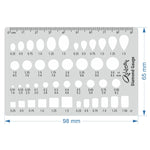
|
Diamond gauge, laser-cut, multi-shape, acrylic (RRP £12.50 ) |
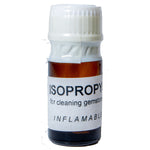
|
Bottle of Isopropyl for cleaning stones (RRP £3.50 ) |
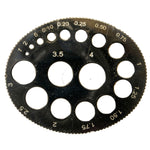
|
Steel Diamond Gauge, oval (RRP £4.50 ) |
QUESTIONS & ANSWERS
Ask a Question-
Can i use it on set stones, rings and necklaces etc
Yes.
-
Does it work with rough uncut diamonds? If not which one does?
No, only works with cut diamonds.
Best for uncut stones, Multi Experior. The tester (any tester!) must be able to make good contact with the stone, e.g. OK for nice clean crystals, won't work on diamond covered in a crust / embedded in quartz.





